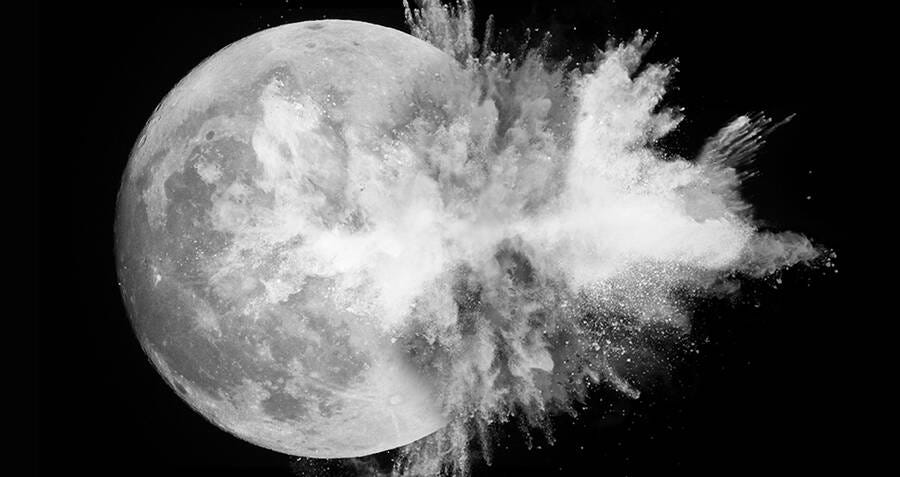Banning Nuking of the Moon: Project A119 and Project E4
At the height of the Cold War, the U.S. and the U.S.S.R raced—nay, sprinted—to nuke the surface of the Moon.
In what is now known as Project A119 from the Americans and Project E-4 from the Soviets, these two plans involved detonating a nuclear warhead on the moon’s surface in a show of force to frighten the other power potentially into submission.
Project A119, as it was known, was a top-secret proposal to detonate a hydrogen bomb on the Moon. Hydrogen bombs were vastly more destructive than the atomic bomb dropped on Hiroshima in 1945, and the latest in nuclear weapon design at the time. “While it might have helped to answer some geological scientific questions about the Moon, Project A119's primary purpose was as a show of force,” with detonation occurring strategically along the Terminator Line – the border between the light and dark side of the Moon. This would have enabled anyone (particularly the Soviets) to have seen a bright flash and bombing of the moon, although there would not have been a typical mushroom cloud as the Moon does not have its own atmosphere.
A similar plan, Project E4, was developed by the Soviets.
However, both plans were fortunately scrapped. Both the Americans and Soviets simply realized that landing on the Moon was the bigger prize. And along additional lines, the Soviets are said to have abandoned their plan out of the fear that a failed launch could result in the bomb dropping down on Soviet soil, and creating potentially a "highly undesirable international incident".
As the BBC suggests, can you imagine what it would’ve been like if Neil Armstrong stepped out onto the Moon's surface in 1969 not on a typical moon crater but on a landscape carved out by a nuke or otherwise poisoned from the effects of nuclear bombardment? I certainly can’t.
Artist rendering of a nuke on the moon — this one would be pretty catastrophic.
Takeaways and Resources 🚀
2 Takeaways
Space Policy Saves the Day Again: The signing of the Partial Nuclear Test Ban Treaty in 1963 and the Outer Space Treaty in 1967 prevented future investigation of the concept of detonating a nuclear device on the Moon. But by then, the United States and the Soviet Union had performed several high-altitude nuclear explosions, including the Starfish Prime and the Soviet Project K launches, which I covered in a previous article here.
Radiation is yet another concern again. Yet another reason why the idea was dismissed was because it would interfere with plans to measure the Moon's natural background radiation and would permanently alter geological data and thereby ruin the moon as a reference point for astronomical and astrophysical measurements.
2 Resources
Read the BBC’s article on the missions: https://www.bbc.com/future/article/20230505-the-crazy-plan-to-explode-a-nuclear-bomb-on-the-moon
Read the released Project A119 document here: https://nsarchive2.gwu.edu/NSAEBB/NSAEBB479/docs/EBB-Moon02.pdf
NASA Photo of the Day 🌔
Explanation: An unassuming region in the constellation Taurus holds these dark and dusty nebulae. Scattered through the scene, stars in multiple star systems are forming within their natal Taurus molecular cloud complex some 450 light-years away. Millions of years young and still going through stellar adolescence, the stars are variable in brightness and in the late phases of their gravitational collapse. Known as T-Tauri class stars they tend to be faint and take on a yellowish hue in the image. One of the brightest T-Tauri stars in Taurus, V773 (aka HD283447) is near the center of the telescopic frame that spans over 1 degree. Toward the top is the dense, dark marking on the sky cataloged as Barnard 209.
Authors & editors: Robert Nemiroff (MTU) & Jerry Bonnell (UMCP)
Daily Opportunity Drop 🌌
Check out this radiation engineer role at Axiom Space posted earlier this month: https://www.google.com/search?q=radiation+engineer+jobs&rlz=1C5GCCM_en___US1127&oq=radiation+engin&gs_lcrp=EgZjaHJvbWUqDggAEEUYJxg7GIAEGIoFMg4IABBFGCcYOxiABBiKBTIGCAEQRRg5MgcIAhAAGIAEMgcIAxAAGIAEMgcIBBAAGIAEMgcIBRAAGIAEMgcIBhAAGIAEMgcIBxAAGIAEMg0ICBAAGIYDGIAEGIoFMg0ICRAAGIYDGIAEGIoF0gEIMTI1MWowajeoAgCwAgA&sourceid=chrome&ie=UTF-8&jbr=sep:0&udm=8#vhid=vt%3D20/docid%3D9hj1R9tuPP4KnEwVAAAAAA%3D%3D&vssid=jobs-detail-viewer&sxsrf=ADLYWIK-XmlwDpmGXVEHxUPGJybc14gWUw:1736721269159






